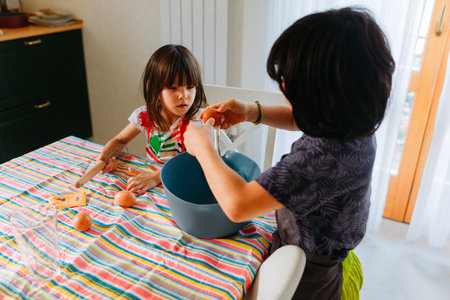Understanding the Benefits of Baby Sign Language in Early Childhood Settings
Introducing baby sign language to daycare and preschool settings is becoming more popular in the United States, and for good reason. This approach helps bridge the communication gap before young children can speak clearly, making daily life smoother for both kids and their caregivers. Here’s how baby sign language can make a difference:
1. Supporting Communication
Many infants and toddlers want to express themselves before they have the words to do so. By teaching simple signs like “more,” “all done,” “eat,” or “please,” caregivers give children a way to share their needs and feelings. This can be especially helpful in group care environments where staff are responsible for several children at once.
Common Signs Used in Daycare and Preschool
| Sign | Meaning | How to Use |
|---|---|---|
| More | I want more (food, play, etc.) | Tapping fingertips together repeatedly |
| All Done | I’m finished/No more | Turning hands outward (palms up) from chest |
| Eat | I’m hungry/Let’s eat | Tapping fingers to mouth |
| Please | Manners/Requesting politely | Circular motion with open hand on chest |
| Help | I need help/Assistance needed | One hand flat, other hand makes a thumbs-up on top of it, then lift both together slightly upward |
2. Reducing Frustration for Children and Caregivers
Lack of communication is a major source of frustration for young kids—and the adults caring for them. When children can sign what they need or how they feel, tantrums and meltdowns often decrease. Caregivers report feeling less stressed because they don’t have to guess what each child wants or needs. This creates a calmer, happier atmosphere for everyone.
3. Promoting Language Development
Some parents and teachers worry that using signs might delay spoken language, but research shows the opposite. Signing actually supports verbal development by helping children connect words with meaning faster. Many American daycares now use baby sign language as part of their early learning curriculum, finding that it encourages kids to start talking sooner and with more confidence.
Benefits at a Glance: Baby Sign Language in Group Settings
| Benefit for Kids | Benefit for Caregivers & Teachers |
|---|---|
| Easier to express basic needs and feelings | Smoother transitions and routines throughout the day |
| Less frustration, fewer tantrums or outbursts | Reduced guesswork about what each child wants or needs |
| Boosts understanding of spoken words and concepts | Greater connection with children through shared communication tools |
| Builds social skills and confidence early on | A more positive, engaged classroom environment overall |
2. Addressing Common Misconceptions and Concerns
Understanding the Hesitations
When introducing baby sign language in daycare and preschool settings, it’s normal for caregivers and staff to have questions or even concerns. Some of these concerns come from myths or misunderstandings about what baby sign language is and how it affects a child’s development. Let’s take a closer look at these common worries and what research actually says.
Common Myths vs. Facts
| Myth | Fact |
|---|---|
| Baby sign language will delay speech development. | Research shows that using signs does not delay speech. In fact, many children who use signs start talking earlier because signing helps them connect words with meanings. |
| It’s only for children with hearing problems. | All babies can benefit from sign language, not just those who are deaf or hard of hearing. Signing is a tool to support communication for every child. |
| It’s too complicated for young children or caregivers to learn. | Most programs focus on simple, everyday signs like “more,” “eat,” and “all done.” Kids pick up these signs quickly, and training resources make it easy for adults to learn as well. |
| Signing takes too much time away from other learning activities. | You can easily include signing during daily routines—like mealtimes or play—without taking extra time away from other lessons or activities. |
The Science Behind Baby Sign Language
Studies in child development show that baby sign language supports early communication skills. When children use signs, they often experience less frustration because they can express their needs before they can speak clearly. This can lead to fewer tantrums and a more positive environment in the classroom.
Key Benefits Backed by Research:
- Improved Communication: Babies who use sign language can share their thoughts earlier than those who don’t.
- No Speech Delays: There is no evidence that signing slows down verbal speech. In fact, it often encourages talking!
- Stronger Bonding: Caregivers and children connect better when they understand each other’s needs faster.
- Easier Transitions: Signing helps kids adjust smoothly during daily routines like snack time or nap time.
Addressing Caregiver Concerns Directly
If you’re a caregiver worried about using baby sign language, remember that you’re not alone! Many parents and teachers had the same questions before they tried it out. The good news is, you don’t need to be an expert right away. Start small with a few basic signs, add more as you feel comfortable, and watch as children begin to respond in wonderful ways.
![]()
3. Practical Steps for Introducing Baby Sign Language
Why Integrate ASL in Daycare and Preschool?
Using baby sign language in early childhood settings helps young children express their needs before they can speak clearly. It also supports language development and makes daily routines run more smoothly. By introducing a few basic American Sign Language (ASL) signs, teachers and caregivers can encourage communication and reduce frustration for both children and staff.
Step-by-Step Guide to Introducing ASL Signs
- Start Small: Begin with 3–5 essential signs that fit naturally into your daily routine, such as “more,” “all done,” “eat,” “milk,” and “please.”
- Train Caregivers: Organize a short training session or share video resources showing how to perform each sign correctly.
- Use Signs Consistently: Incorporate the chosen signs into regular activities like snack time, circle time, and diaper changes.
- Model the Signs: Make eye contact and say the word while signing it, so children connect the gesture with the meaning.
- Encourage Participation: Prompt children gently to use signs when expressing needs or responding to questions.
- Reinforce and Celebrate: Offer positive feedback when a child attempts or uses a sign, even if it’s not perfect.
Sample Daily Routine with ASL Signs
| Activity | Recommended Sign(s) | How to Use |
|---|---|---|
| Snack Time | “Eat,” “More,” “All Done” | Ask if children want to eat using the sign for “eat.” Use “more” for seconds, and “all done” when finished. |
| Circle Time | “Please,” “Sit,” “Friend” | Invite children to sit using the sign for “sit” and encourage sharing or greeting friends with relevant signs. |
| Diaper Change/Bathroom | “Change,” “Help” | Let children know its time to change diapers using the sign for “change,” and offer help with the “help” sign. |
| Naptime | “Sleep,” “Blanket” | Signal naptime by signing “sleep” and offer comfort by signing “blanket.” |
Troubleshooting Common Challenges
- Lack of Confidence: Remind staff that perfection isn’t necessary—consistency is key. Encourage practicing signs together as a team.
- No Time for Extra Lessons: Integrate signs into activities you’re already doing instead of adding new tasks.
- Forgetting to Sign: Place visual reminders (like posters or flashcards) around classrooms as gentle prompts for both staff and kids.
Making It Manageable for Busy Settings
You don’t have to become fluent in ASL overnight. Focus on a handful of practical signs, practice them regularly, and celebrate small successes. Over time, both caregivers and children will feel more comfortable—and communication will improve throughout your daycare or preschool community.
4. Training and Supporting Caregivers
Getting caregivers comfortable with baby sign language is a key part of making it work in daycare and preschool settings. With the right training and support, caregivers can confidently use sign language every day, helping little ones communicate their needs and feelings even before they can talk. Here are some practical strategies to train and support your team:
Workshops: Hands-On Learning
Interactive workshops are a great way to introduce baby sign language. These sessions allow caregivers to see signs in action, practice them together, and ask questions in real time. Consider bringing in an experienced instructor or using online platforms that offer live demonstrations. Make sure workshops cover basic signs for common needs like “more,” “all done,” “eat,” and “help.”
Resource Materials: Easy Reference Tools
After initial training, provide simple resources so caregivers have reminders at their fingertips. These can include:
| Resource Type | Description |
|---|---|
| Sign Language Charts | Visual guides showing commonly used signs, posted in classrooms or break rooms. |
| Pocket Cards | Small cards with pictures and descriptions of key signs for quick reference during the day. |
| Video Clips | Short videos demonstrating each sign, accessible via phone or computer. |
| Printable Handouts | Step-by-step guides for parents and new staff members to take home or review anytime. |
Peer Collaboration: Learning Together
Create opportunities for caregivers to share tips and experiences with each other. This could be as simple as a weekly check-in where staff discuss which signs are working well or brainstorm solutions for challenges they face. Pairing up new staff with more experienced colleagues can also help everyone feel supported as they learn baby sign language together.
Quick Tips for Ongoing Success
- Encourage caregivers to use signs consistently throughout the day, not just during specific activities.
- Celebrate small wins—like a child successfully signing “more” for the first time—to boost confidence.
- Invite feedback from caregivers about what’s working or what additional resources would be helpful.
With hands-on training, accessible resources, and a supportive team environment, caregivers will feel empowered to use baby sign language—and children will benefit from better communication and connection every day.
5. Building Collaboration and Communicating with Families
Why Family Involvement Matters
Getting families involved in baby sign language makes a big difference in how well children learn and use signs. When parents and caregivers work together, kids see the same signs both at home and in daycare or preschool. This consistency helps children feel more confident and communicate better.
Best Practices for Involving Families
- Share Information Regularly: Let families know what signs you’re teaching in class. Send home simple guides, videos, or pictures so parents can practice too.
- Host Parent Workshops: Invite families to fun, hands-on sessions where they can learn basic signs. Encourage them to ask questions and share their own ideas.
- Use Technology: Set up a private class webpage or app to post updates, demonstration videos, and new vocabulary. This keeps everyone on the same page.
- Encourage Daily Practice: Suggest easy ways for families to use signs during daily routines like mealtime, bath time, or bedtime.
Simple Ways to Keep Families Connected
| At Daycare/Preschool | At Home |
|---|---|
| Practice signs during circle time and activities | Practice the same signs while reading or playing |
| Send home weekly “sign of the week” flyers | Hang flyers on the fridge as a reminder |
| Share photos or videos of kids using signs | Take short videos of signing at home to share with teachers |
| Invite parents to observe a signing session | Join virtual workshops if they can’t attend in person |
Communicating Progress and Benefits
- Regular Updates: Let parents know how their child is doing with signing—share successes, new words learned, and any fun stories.
- Highlight Benefits: Remind families that baby sign language supports language development, reduces frustration, and strengthens bonds between adults and children.
- Create Feedback Loops: Encourage parents to let you know what’s working at home or if they have any challenges. This way, you can adjust your approach together.
Together is Better!
The best results happen when everyone works as a team. By sharing resources, celebrating progress, and keeping communication open, families and caregivers help children build strong early communication skills through baby sign language.


